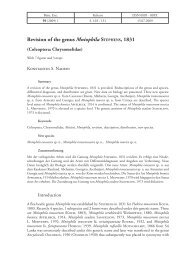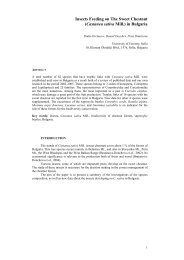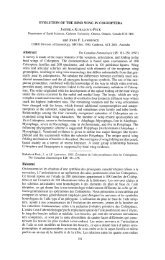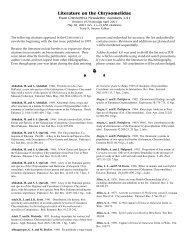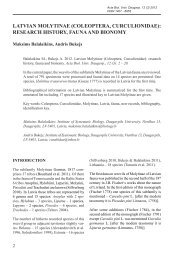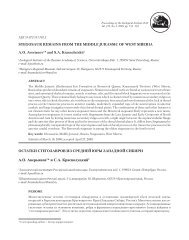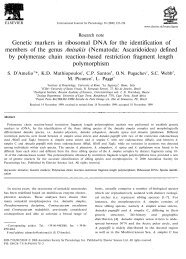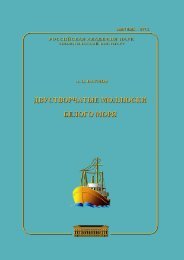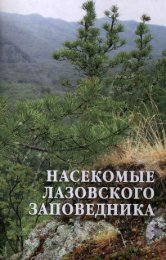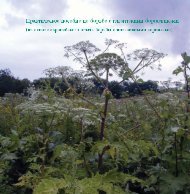International Meeting on Biology and Systematics of Staphylinidae
International Meeting on Biology and Systematics of Staphylinidae
International Meeting on Biology and Systematics of Staphylinidae
You also want an ePaper? Increase the reach of your titles
YUMPU automatically turns print PDFs into web optimized ePapers that Google loves.
22nd <str<strong>on</strong>g>Internati<strong>on</strong>al</str<strong>on</strong>g> <str<strong>on</strong>g>Meeting</str<strong>on</strong>g> <strong>on</strong> <strong>Biology</strong> <strong>and</strong> <strong>Systematics</strong> <strong>of</strong> <strong>Staphylinidae</strong> 2007 – abstracts<br />
the clade Euaesthetinae + Steninae is well established, but recent published studies have suggested<br />
that Euaesthetinae is paraphyletic with respect to Steninae, as there are no known autapomorphies<br />
for Euaesthetinae. This talk reviews some major systematic problems within the<br />
clade Euaesthetinae + Steninae, pitches these problems within a phylogenetic c<strong>on</strong>text, <strong>and</strong><br />
focuses <strong>on</strong> the south temperate endemic genera.<br />
Almost half <strong>of</strong> the known euaesthetine genera <strong>and</strong> two <strong>of</strong> the tribes (Austroesthetini, Alzadaesthetini)<br />
are endemic to the south temperate regi<strong>on</strong> <strong>and</strong> the relati<strong>on</strong>ships <strong>of</strong> these genera<br />
to each other <strong>and</strong> to other genera are unknown. Some major morphological characters are reviewed,<br />
including potential autapomorphies for Euaesthetinae, <strong>and</strong> using recent adult morphological<br />
data some new hypotheses for generic relati<strong>on</strong>ships are explored. It is suggested that<br />
Alzadaesthetini, most <strong>of</strong> the genera <strong>of</strong> Austroesthetini, <strong>and</strong> Stenaesthetini may be more<br />
closely related to each other than to members <strong>of</strong> any other tribes. Two new undescribed genera<br />
<strong>and</strong> their systematic placement are briefly discussed in light <strong>of</strong> these other hypotheses. It<br />
is c<strong>on</strong>cluded that phylogenetic studies <strong>of</strong> the Euaesthetinae will be significantly hampered by<br />
the dominance <strong>of</strong> homoplastic characters, reducti<strong>on</strong>s, <strong>and</strong> parallel changes related to the specialized<br />
habitats <strong>of</strong> these beetles. A phylogenetic reclassificati<strong>on</strong> <strong>of</strong> the subfamily will likely<br />
require the input <strong>of</strong> molecular data <strong>and</strong> high-density tax<strong>on</strong> sampling across all genera to reach<br />
stability, <strong>and</strong> still seems to be a distant reality.<br />
About Stenus aggregates <strong>on</strong> top <strong>of</strong> Mt Borail (Assam, India)<br />
GIULIO CUCCODORO<br />
Muséum d’histoire naturelle, Genève, Switzerl<strong>and</strong><br />
e-mail: Giulio.Cuccodoro@ville-ge.ch<br />
The Mt Borail is located in North East India in the South <strong>of</strong> the State <strong>of</strong> Assam (Axom).<br />
This about 1800 m high mountain is still densely covered with lush forests. On the 17th <strong>of</strong><br />
October 2005, I climbed it together with Aless<strong>and</strong>ro Marletta (Catania, Italy) <strong>and</strong> my Hado<br />
Kookie friend Chungkholien Lhouvum (Notun Leikul, Assam). We reached the summital<br />
clearing at 2.30 PM. It was cloudy with almost no wind. There, our attenti<strong>on</strong> was casually<br />
drawn <strong>on</strong>to the base <strong>of</strong> a nearby tree at the forest edge by dozens <strong>of</strong> tiny dark mobile spots<br />
c<strong>on</strong>trasting with its pale bark. Giving the tree a closer look, I so<strong>on</strong> realised that the dark spots<br />
were adults Stenus Latreille (Coleoptera <strong>Staphylinidae</strong> Steninae). They were present in such a<br />
number that they could be found almost everywhere <strong>on</strong> the trunk up to 1.5 m high, as well as<br />
<strong>on</strong> the surrounding couple <strong>of</strong> square meters <strong>of</strong> vegetati<strong>on</strong>. They were all together well above<br />
5'000 specimens as if uniformly scattered at a 3-5 cm distance from each other <strong>on</strong> the bark<br />
<strong>and</strong> leaves <strong>of</strong> the tree, as well as <strong>on</strong> neighbouring mosses, ferns, grasses, branches <strong>and</strong> other<br />
vegetati<strong>on</strong>al debris <strong>on</strong> the ground. Density <strong>of</strong> individuals was particularly high underneath<br />
some recurved dead broadleaves <strong>and</strong> in shallow cavities <strong>of</strong> the trunk, where they could form a<br />
nearly compact layer exceeding 5 individuals / cm<br />
__________________________________________________________________________________________<br />
2 . Most individuals appeared moderately<br />
active, <strong>and</strong> they were many couples in copula. I sampled several hundreds <strong>of</strong> specimens <strong>of</strong><br />
various sizes, all <strong>of</strong> which proved later to bel<strong>on</strong>g to an undescribed species <strong>of</strong> Stenus resembling<br />
S. stigmaticus Fauvel (V. Puthz pers. com.). The aggregate was still going <strong>on</strong> when we<br />
left the place at 3.30 PM. The next morning we returned to the summital clearing <strong>and</strong> decided<br />
to stay there for a couple <strong>of</strong> nights. The top <strong>of</strong> Mt Borail was in the clouds at our late morning<br />
arrival <strong>and</strong> by no<strong>on</strong> a gentle drizzle started moisturing the place. We couldn’t find even a single<br />
Stenus <strong>on</strong> or near ‘the’ trunk before rain poored <strong>on</strong> us from 3 PM until late at night. The<br />
19th <strong>of</strong> October was sunny until the late morning formati<strong>on</strong> <strong>of</strong> a thick layer <strong>of</strong> altostratus,<br />
which obscured the sun throughout the afterno<strong>on</strong>. It was about 1 PM when we first noticed<br />
Staatliches Museum für Naturkunde Stuttgart 6




